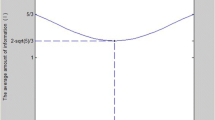Abstract
A violation of a Bell inequality can formally be expressed as a witness for quantum nonlocality. A new four-qubit Bell inequality is optimally violated by \(\chi \)-type entangled state, but not by four-qubit GHZ, W and cluster state. Hence, \(\chi \)-type entangled state is a good candidate to implement simultaneous dense coding. In this paper, we propose a simultaneous dense coding protocol with genuine four-particle entangled state, \(\chi \)-type entangled state, in which two receivers can simultaneously obtain their respective classical information sent by a sender. The double controlled-NOT operator, which is used as the locking operator, play a crucial role in our protocol. The security of simultaneous dense coding is analyzed against the intercept-resend attack. The preparation of \(\chi \)-type entangled state has been studied in various physics systems, and it has been experimentally generated with nearly deterministic scheme and high generation rate. Thus, our protocol is feasible with the current experimental technology.


Similar content being viewed by others
References
Horodecki, R., Horodecki, P., Horodecki, M., Horodecki, K.: Quantum entanglement. Rev. Mod. Phys. 81, 865 (2009)
Bennett, C.H., Brassard, G., Crépeau, C., Jozsa, R., Peres, A., Wootters, W.K.: Teleporting an unknown quantum state via dual classical and Einstein–Podolsky–Rosen channels. Phys. Rev. Lett. 70, 1895 (1993)
Bennett, C.H., Wiesner, S.J.: Communication via one-and two-particle operators on Einstein-Podolsky-Rosen states. Phys. Rev. Lett. 69, 2881 (1992)
Wootters, W.K.: Entanglement of formation of an arbitrary state of two qubits. Phys. Rev. Lett. 80, 2245 (1998)
Verstraete, F., Dehaene, J., De Moor, B., Verschelde, H.: Four qubits can be entangled in nine different ways. Phys. Rev. A 65, 052112 (2002)
Yeo, Y., Chua, W.K.: Teleportation and dense coding with genuine multipartite entanglement. Phys. Rev. Lett. 96, 060502 (2006)
Wu, C., Yeo, Y., Kwek, L.C., Oh, C.H.: Quantum nonlocality of four-qubit entangled states. Phys. Rev. A 75, 032332 (2007)
Wang, X.W., Yang, G.J.: Generation and discrimination of a type of four-partite entangled state. Phys. Rev. A 78, 024301 (2008)
Dong, L., Wang, J.X., Li, Q.Y., Dong, H.K., Xiu, X.M., Gao, Y.J.: Teleportation of a general two-photon state employing a polarization-entangled \(\chi \)-type state with nondemolition parity analyses. Quantum Inf. Process. 15, 2955 (2016)
Fu, H., Chen, G.B., Li, X.W., Ma, P.C., Zhan, Y.B.: Joint remote preparation of an arbitrary four-qubit \(\chi \)-type entangled state. arXiv preprint. arXiv: 1605.05446 (2016)
Kang, S.Y., Chen, X.B., Yang, Y.X.: Multi-party quantum state sharing of an arbitrary multi-qubit state via \(\chi \)-type entangled states. Quantum Inf. Process. 13, 2081 (2014)
Xiu, X.M., Dong, L., Gao, Y.J.: Secure four-site distribution and quantum communication of \(\chi \)-type entangled states. Opt. Commun. 7, 284 (2011)
Dong, L., Xiu, X.M., Gao, Y.J., Yi, X.X.: A nearly deterministic scheme for generating -type entangled states with weak cross-Kerr nonlinearities. Quantum Inf. Process. 12, 1787 (2013)
Mozes, S., Oppenheim, J., Reznik, B.: Deterministic dense coding with partially entangled states. Phys. Rev. A 71, 012311 (2005)
Pati, A.K., Parashar, P., Agrawal, P.: Probabilistic superdense coding. Phys. Rev. A 72, 012329 (2005)
Liu, X.S., Long, G.L., Tong, D.M., Li, F.: General scheme for superdense coding between multiparties. Phys. Rev. A 65, 022304 (2002)
Bruß, D., Lewenstein, M., Sen, A., Sen, U., D’ariano, G.M., Macchiavello, C.: Dense coding with multipartite quantum states. Int. J. Quantum Inf. 4, 415 (2006)
Agrawal, P., Pati, A.: Perfect teleportation and superdense coding with W states. Phys. Rev. A 74, 062320 (2006)
Li, L., Qiu, D.: The states of W-class as shared resources for perfect teleportation and superdense coding. J. Phys. A., Math. Theor. 40, 10871 (2007)
Situ, H., Qiu, D.: Simultaneous dense coding. J. Phys. A, Math. Theor. 43, 055301 (2010)
Situ, H., Qiu, D., Mateus, P., Paunković, N.: Secure N-dimensional simultaneous dense coding and applications. Int. J. Quantum Inf. 13, 1550051 (2015)
Zhang, C., Situ, H., Li, Q., He, G.P.: Efficient simultaneous dense coding and teleportation with two-photon four-qubit cluster states. Int. J. Quantum Inf. 14, 1650023 (2016)
Situ, H.: Controlled simultaneous teleportation and dense coding. Int. J. Theor. Phys. 53, 1003 (2014)
Huang, Z., Zhang, C., Situ, H.: Performance analysis of simultaneous dense coding protocol under decoherence. Quantum Inf. Process. 16, 227 (2017)
Oh, C., Kim, H., Jeong, K., Jeong, H.: Minimal control power of controlled dense coding and genuine tripartite entanglement. Sci. Rep. 7, 3765 (2017)
Acknowledgements
This work is supported by the National Natural Science Foundation of China (Grant No. 11671284), Sichuan Provincial Natural Science Foundation of China (Grant Nos. 2015JY0002, 2017JY0197) and the Research Foundation of the Education Department of Sichuan Province (Grant No. 15ZA0032).
Author information
Authors and Affiliations
Corresponding author
Appendix
Appendix
In this appendix, we present a detailed proof of theorem mentioned in Sect. 3. In following theorem, we can see that the reduced density matrix in subsystem \(A_1B\) and in subsystem \(A_2C\) are the same, which are independent of \(b_1,b_2,b_3,b_4,c_1,c_2,c_3,c_4\). That means Bob and Charlie can know nothing about their respective information that Alice wants to send to them unless they collaborate.
Theorem
For each \(b_1,b_2,b_3,b_4,c_1,c_2,c_3,c_4\in \{0,1\}\), \(\rho _{3214}=\rho _{3^{\prime }2^{\prime }1^{\prime }4^{\prime }}=\frac{I}{16}\), where \(\rho _{3214}\) and \(\rho _{3^{\prime }2^{\prime }1^{\prime }4^{\prime }}\) are the reduced density matrices in subsystems \(A_1B\) and \(A_2C\), after step (2) (but before step (3)).
Proof
Case 1 When \(i=j\), or \(i=00, j=01\), or \(i=01, j=00\), or \(i=10, j=11\), or \(i=11, j=10\), after step (2), the state of the composite system becomes
The reduced density matrix in subsystem \(A_1B\) is
Similarly, the reduced density matrix in subsystem \(A_2C\) is also \(\frac{I}{16}\).
Case 2 When any one of these conditions of \(i=j\), or \(i=00, j=01\), or \(i=01, j=00\), or \(i=10, j=11\), or \(i=11, j=10\) is not satisfied, after step (2), the state of the composite system becomes
The reduced density matrix in subsystem \(A_1B\) is
Similarly, the reduced density matrix in subsystem \(A_2C\) is also \(\frac{I}{16}\). \(\square \)
Rights and permissions
About this article
Cite this article
Yang, X., Bai, Mq., Zuo, Zc. et al. Secure simultaneous dense coding using \(\chi \)-type entangled state. Quantum Inf Process 17, 261 (2018). https://doi.org/10.1007/s11128-018-2022-7
Received:
Accepted:
Published:
DOI: https://doi.org/10.1007/s11128-018-2022-7



